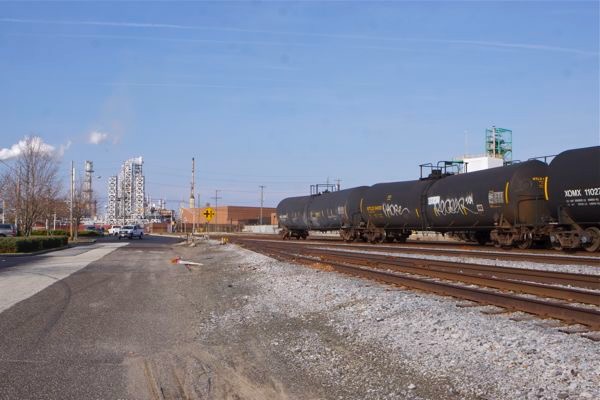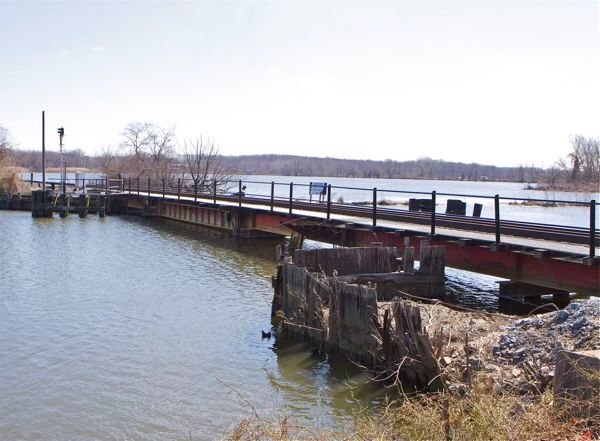EPA Enforcement Goes Easy On Toxic Polluter In Paulsboro, NJ For Extended Violations Of Hazardous Chemical Reporting Requirements
Toxic Polluter Concealed Data From Regulators On Carcinogenic Chemical At A Critical Time
Paltry $70 Per Day Fine Levied On Coim, Inc. For 4 Years Of False Chemical Reporting
Donation To Local Fire Department Exposes Failure To Respond To Prior Chemical Disaster That Forced Evacuation

a few hundred feet from the High School, unsecured chemical rail cars, COIM chemical plant and refinery form a daily toxic nightmare for the people of Paulsboro
The US EPA just issued an enforcement fine against COIM, Inc. According to the EPA press release: (emphasis mine)
EPA reached a settlement with COIM USA, Inc. (COIM) for allegedly violating the federal Emergency Planning and Community Right-to-Know Act (EPCRA) at their chemical manufacturing facility in West Deptford, New Jersey. Failure of facilities to accurately disclose chemical information deprives local community members and officials of their right to know about releases and the presence of chemicals in their neighborhoods. Under the settlement, COIM will pay a $101,400 penalty. Additionally, the company will undertake a supplemental environmental project (SEP) estimated to cost approximately $25,000 to purchase emergency planning and preparedness equipment for the West Deptford Fire Department.
A little context and history is necessary in order to understand just how serious the violations were and just how lame this EPA enforcement response is. It is an insult to the community and illustrates a longtime pattern of lax regulation and enforcement.
Paulsboro, NJ is a working class community located in the middle of a giant Petro-chemical complex along the Delaware River. It is a place I’ve called a “sacrifice zone”, given the concentration of toxic polluters and virtual abandonment by lax government regulators who have been captured by those corporate polluters.
In addition to daily ongoing toxic pollution, the Pauslboro refinery routinely has “upsets” that belch toxic air pollutants, just a few hundred feet from the High School.
A decade ago, a train loaded with toxic chemicals, traveling over a decrepit rail bridge, derailed and released a toxic cloud that forced evacuation of the community.

scene of the crime. Rail bridge over 100 years old – millions of pounds of toxic chemicals regularly cross this bridge.
The National Transportation Safety Board (NTSB) issued an accident Report in 2014 documenting numerous failures – validating our severe criticism written shortly after that derailment.
One of the many failures NTSB criticized included a lack of local chemical emergency planning, preparedness, training, equipment, response capacity, and community awareness and involvement. The State DEP’s response was also strongly criticized by NTSB.
This history exposes why the EPA enforcement action is so flawed.
First let’s look at COIM’s violation (EPA):
The settlement resolves EPA’s allegations that COIM failed to accurately report the off-site transfers and disposal methods of 1,4-Dioxane, in their Toxics Release Inventory (TRI) reports for the years 2018, 2019, 2020 and 2021. The TRI program requires facilities that manufacture, process, or otherwise use certain toxic chemicals above threshold levels to report annually on their releases and other waste management activities. In response to EPA’s request for the raw data and information that supported their 1,4-Dioxane TRI reports, COIM identified chemical records they had previously not considered and reevaluated their calculations and waste transfer descriptions. Accordingly, COIM updated its calculations and waste transfer descriptions, fixed its TRI reports, and set up internal controls to prevent future violations.
These are not minor paperwork violations, because they put the entire community’s health, safety, and environment at risk. According to the NJ DEP:
Information on health effects of 1,4-dioxane comes primarily from studies of laboratory animals, which show that prolonged exposure to low levels of 1,4-dioxane may result in adverse health impacts. Research suggests lifelong exposure to 1,4-dioxane may be associated with an increased risk of cancer or damage to the kidneys or liver. The United States Environmental Protection Agency (EPA) has classified the chemical as “likely to be carcinogenic to humans” from long-term exposure.
In addition to its human health impacts, 1,4 dioxane is also harmful to natural resources. It is a recognized animal carcinogen, and has been shown to be taken up by fish, aquatic microorganisms, and other biota.
The violations were chronic and occurred over a period of more than 4 years.
Furthermore, the failure by COIM to disclose their use, environmental release, and off site disposal of this toxic chemical occurred from 2018 – 2021. That timeframe is critical.
During that timeframe, the NJ DEP was investigating pollution sources of dioxane to the Delaware River, developing groundwater and drinking water standards, and, in March 2023 DEP filed a lawsuit. (see DEP:
So there is strong suspicion that COIM’s failure to disclose accurate information was intentional and designed to deceive regulators and stall regulation, evade liability for Delaware River and local pollution, and frustrate a lawsuit.
These are therefore knowing, bad faith and chronic serious violations that warrant far more severe enforcement fines and penalties.
The EPA fine of $101,400 amounts to just $70 a day for the 4 year period the violations were ongoing.
That’s worse than a joke. It doesn’t even pay the annual salary and benefits of one US EPA employee!
Even worse is the Salvation Army like donation to the West Deptford fire Department: “$25,000 to purchase emergency planning and preparedness equipment for the West Deptford Fire Department” (EPA)
In addition to the penalty, COIM agreed to perform a Supplemental Environmental Project (SEP), which involves purchasing and providing fire turnout gear (safety clothing) for the West Deptford Fire Department. The SEP will help the fire department improve their ability to respond to emergencies involving hazardous chemicals such as 1,4-Dioxane in West Deptford and the surrounding communities.
The West Deptford fire department should have state of the art equipment, given the risks from the concentration of hazardous chemicals in their community.
The EPA driven paltry $25,000 COIM donation of basic items like “safety clothing” reveals that they do not – which is incredibly negligent a decade after a massive toxic train derailment forced evacuation of the community and the NTSB report strongly criticized deficiencies in the local emergency response program.
Finally, the fact that COIM could get away with concealing data on 1,4 dioxane during a time when the DEP was “rigorously” investigating and developing regulations on that chemical illustrates just how lax DEP regulation, environmental monitoring, facility inspection, and enforcement are. DEP literally was blind.